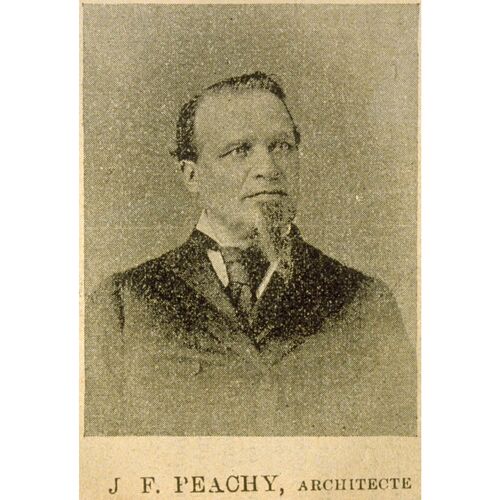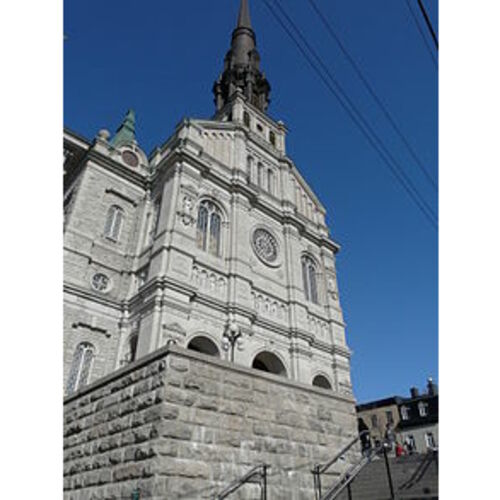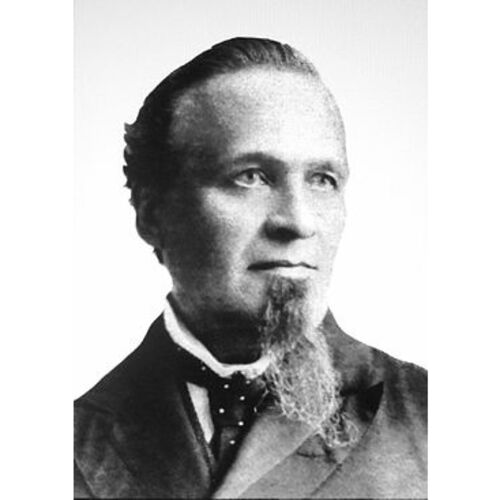PEACHY, JOSEPH-FERDINAND, architect; b. 27 Aug. 1830 at Quebec, son of John William (Jean-Guillaume) Peachy, a tailor, and Marie-Angélique Roussel; d. there 31 Dec. 1903.
John Peachy, Joseph-Ferdinand’s great-grandfather, came to live at Quebec about 1773, and became an apprentice to Henry Dunn, a printer and engraver. His descendants were assimilated into the Quebec community through marriages with francophones from the region. Joseph-Ferdinand was no exception to the family custom. On 23 May 1853 he married Elmire Triaud, daughter of Louis-Hubert Triaud*, at Quebec; then secondly on 9 Nov. 1869 he wedded Caroline Duberger, a granddaughter of Jean-Baptiste Duberger*, at La Malbaie. Eleven children were born of the two marriages.
Peachy’s early education was with the Brothers of the Christian Schools, and when he was about 18 he began studying architecture. He learned drawing from Pierre Gauvreau*, an engineer and architect with the Department of Public Works, and did his training under Charles Baillairgé, the most eminent Quebec architect at the time.
In 1853, at the end of this period of apprenticeship, Peachy furthered his education by working as Baillairgé’s assistant. He did not have responsibility for the work he did until 1858. From 1863 to 1866 he was in partnership with Baillairgé in Baillairgé et Peachy; subsequently he ran an office under his own name until 1895. He then went into partnership with one of his pupils, Joseph-Pierre-Edmond Dussault, in Peachy et Dussault. Throughout his career Peachy had his business premises and residence on Rue Saint-Jean except for a brief period in 1876, when his office was at the corner of Rue Sainte-Anne and Rue du Fort. After Charles Baillairgé gave up his practice in 1866 upon being appointed superintendent of works for the city of Quebec, Peachy’s career moved ahead rapidly. He was commissioned to construct several important buildings in the city, and he made a name for himself as an urban architect. He did a good many churches, chapels, schools, hospitals, public and commercial buildings, and private houses. It was, indeed, religious architecture that made him known in the Quebec region, where he drew up the plans of numerous churches and their interior decorations.
Peachy’s early output was strongly influenced by Baillairgé. The evidence can be seen in the work he did for the Séminaire de Québec, the Ursuline convent, and the fabrique of Notre-Dame at Quebec. Baillairgé followed in the tradition of his great-uncle Thomas Baillairgé*, an advocate of the severe lines of English Palladianism and the neoclassical style. But he also found inspiration in the theoretical work of American architect Minard Lafever, whose overall treatment of edifices was related to the neo-Renaissance mode. These influences are visible in numerous creations of the 1860s. The house built at 14 Rue Saint-Flavien in 1864 and known as the home of historian François-Xavier Garneau* is typical of the neoclassical style in the strict and symmetrical organization of its façade and the disposition of its floors. The three-storey brick shed built in 1863 for merchant James Hunt at 58–60 Rue Saint-Pierre shows the influence of the neo-Renaissance style in its imposing cornice with modillions, richly decorated façade, and ground-floor windows ornamented with stone lintels and a series of carved heads. This style suited to perfection the buildings combining business and residence typical in the second half of the 19th century. The predecessor of the big department store, these houses, designed for mixed use, received customers on the ground floor and accommodated the merchant’s home on the upper floors. The alignment of the bays created a harmonious façade despite the varied functions of the different levels. Peachy was largely instrumental in spreading this new architectural concept at Quebec.
The earliest church for which Peachy fully prepared the plans (including those for the sacristy and presbytery) was built for Saint-Sauveur parish at Quebec in 1867. An obvious characteristic of this edifice was the adoption of a new formal repertory, which he found in the work of American architect Samuel Sloan. On a larger scale, Peachy would help develop a new type of religious architecture adapted to the countryside. A church at Arthabaskaville (Victoriaville) and another, no longer standing, at Chicoutimi display the concept in a grand manner, whereas the undertaking was more modest at Saint-Gervais, Saint-Raphaël in Bellechasse, and Sainte-Foy (whose church was lost in 1914). These buildings had a rather sober façade dominated by a central tower and two symmetrical side turrets or pinnacled buttresses. Their simple plan, consisting of a nave that closed in upon a narrower chancel, allowed a transept having arms with polygonal ends, and the sacristy formed a continuation of the chancel, in conformity with the classical ideal of clearly defined volumes.
After 1876 Peachy forsook the rural milieu for the urban one. This choice led to an élitist architectural practice affording access to a more varied expertise in construction methods, more materials of quality, and new technologies. In the second half of the 19th century the Ursuline convent and the Séminaire de Québec were his principal clients. Peachy had begun to work for the seminary after a fire in 1865. His major achievements included: raising the height a floor and adding the roof of the wing that contained the bursar’s office in 1866; putting a mansard roof on the central building at the Université Laval in 1875; the Grand Séminaire in 1879, with its remarkable central stairway in stone and iron; the chapel of the boarding-school in 1883; and the outer chapel along Rue Sainte-Famine in 1888, which had sheet-metal decoration in trompe-l’œil completed by 1899.
In connection with his work for the seminary Peachy had travelled to Europe in 1879 seeking a fresh approach. The interior decoration of the outer chapel bears witness to his renewal, with its explicit reference to the church of La Trinité in Paris, designed by French architect Théodore Ballu, of which he had obtained the plans. Peachy’s innovativeness was demonstrated at the seminary. The central building of the Université Laval was the first one of importance to have a mansard roof, which was topped with elegant lanterns copied from city halls in the departments of northern France. Thereby Peachy introduced the Second Empire style at Quebec a few years before architect Eugène-Étienne Taché* did the edifice for the legislature (1877–86). Peachy was also responsible as architect for much work at the Ursuline convent, the most important being the construction of two wings between 1865 and 1872. He also built a number of houses on lots that the nuns owned outside the convent, among them the five row-houses at 73–81 Rue Sainte-Anne which were put up in 1876 and constitute an early example of Second Empire style in domestic architecture at Quebec.
Peachy also made his mark as one of the leading architects of commercial and industrial buildings in the city. Besides many houses containing a business and residence, Peachy drew the plans for the Banque Nationale (1862), the Union Bank of Canada (1866), and the Caisse d’Économie of the parish of Notre-Dame-de-Québec (1874). Because of its proximity to the harbour and the railway station, Lower Town Quebec was a suitable site for warehouses. In 1875, for example, Peachy did the plans and specifications for four stores for the faïence and pottery business of J.-B. Renaud et Compagnie located at 72–78 Rue Saint-Paul. These big, narrow buildings, with frontages of 30 feet and a depth of 120 feet, conformed to the previous division of the lots. The shape of the stores made wide mullioned windows necessary, to provide light for the interior. Bevelled columns and embossed stone supports bring out the verticality of the façade on Rue Saint-Paul; a plainer one on Rue Saint-André shows an American influence on the neo-Renaissance style. The latter structure marked the beginning of protorationalist architecture at Quebec, which sought to put up edifices with façades devoid of decoration save for the beams and supporting columns that broke up the windowed surfaces. The warehouse Peachy built in 1880 for Thibeaudeau, Frères et Compagnie combined neo-Renaissance elements (the alignment of the bays and the decoration of the façade) with others in Second Empire style (the mansard roof). Located on the site of the former Finlay Market, it had walls exposed on all four sides, making windows and ornamentation of lateral façades necessary. This arrangement created a building unique in its kind and displays Peachy’s ability to adapt architecture to setting.
It is surprising that Peachy worked for the English-speaking community at Quebec only by exception. For example, following a competition in which six architects from Toronto, Montreal, and Quebec took part anonymously, the Young Men’s Christian Association commissioned Peachy, who was using the pseudonym Fideo, to prepare the plans and specifications for the first YMCA at Quebec in 1879. The building had a ground floor in freestone and an upper storey in bossage, and a slate mansard roof of various colours crowned with iron ridges and ornamental chimneys. It bore witness to the architect’s penchant for combining diverse architectural tendencies. His interest in eclecticism, characteristically profuse in decorative elements, is manifest in the houses that Peachy built between 1877 and 1895 on the Grande Allée. These include a few examples of suburban houses as defined by French architect César Dali in the Revue générale de l’architecture et des travaux publics (Paris), the first architectural journal in the world. The Second Empire style, which was associated with wealth and prestige, met with the approval of the Quebec bourgeoisie. Because of the need for density of occupancy the houses were built in rows of semi-detached single-family dwellings. As they are set back a little from the street, a few elements that individualize the façades can be picked out. Among others Peachy created various ensembles: six houses (no longer standing) for the merchant Abraham Hamel in 1877, three houses at 661–75 Grande Allée for businessman Abraham Joseph* in 1882, and eleven houses for alderman Louis Bilodeau in 1895 at 455–555 Grande Allée.
Peachy returned to religious architecture in striking fashion when he was commissioned to rebuild the church of Saint-Jean-Baptiste, which had been destroyed in the fire that swept the quarter in 1881. He developed the plans for it shortly after his stay in Europe. This monument can be considered the manifesto of Peachy’s architectural stance: his adhesion to classical French eclecticism or the Second Empire style. But it is the church’s interior that reveals Peachy’s talent as a master of architectural composition. Each decorative element can be traced back to Ballu’s engravings, but the disposition of the forms, their spatial treatment, and the effect obtained are characteristic of Peachy’s manner, which became increasingly personal. The church of Saint-Jean-Baptiste is undoubtedly his masterpiece. It also drove him to financial ruin and caused some loss of credibility in regard to his way of practising as the 1890s approached: when cracks appeared in the inside wall of the front façade, the masonry work, which had been done by a none too careful contractor, had to be suspended. The fabrique of Notre-Dame then held Peachy jointly responsible with the contractor for the construction defects in the church. After the lawsuit, the portal was demolished and rebuilt at the expense of the architect, who oversaw completion of the building.
In 1890 Peachy submitted an entry in the competition for building a new Quebec city hall. The winning design, for a structure in Second Empire style, came from architect Elzéar Charest*. The municipal council considered it too simple, however, and commissioned Peachy to prepare an amalgamation of the plans presented in the competition. His synthesis was refused, and finally in 1894 the council accepted architect Georges-Emile Tanguay*’s new proposal. The rejection of Peachy’s plans and synthesis was an indication of his decline, which could be attributed to the lengthy lawsuit over the church of Saint-Jean-Baptiste and a certain dwindling of interest in the French-inspired style in the late 19th century.
Regarded by his fellow citizens as an honest and generous man, Peachy held various titles and offices: member of the municipal council of Quebec from 1868 to 1888, chairman of the roads and waterworks committees, churchwarden with the fabrique of Saint-Jean-Baptiste, member of the Council of Arts and Manufactures of the Province of Quebec, president of the Quebec Friendly Society (1876–77) and the city’s Société Saint-Jean-Baptiste (1893–95), and founding member and president (1898) of the Architects’ Association of the Province of Quebec.
Peachy had a considerable influence as an architect, witness the numerous creations by his pupils and successors, who included Georges-Emile Tanguay, Alfred Vallée, Jean-Baptiste Saint-Michel, Charles Bernier, and Joseph-Pierre-Edmond Dussault, who took over Peachy’s office. when he died. The tradition was maintained by Peachy’s descendants. A grandson, Ludger Robitaille*, set up in business as an architect shortly before 1920, and beginning in 1955 Robitaille’s nephew André devoted himself to architecture and architectural conservancy.
AC, Québec, État civil, Catholiques, Saint-Jean-Baptiste (Québec), 2 janv. 1904. ANQ-Q, CE1-1, 27 août 1830; CE4-3, 9 nov. 1869. Denyse Légaré, “Sur les pas d’un architecte, Joseph-Ferdinand Peachy, 1830–1903: l’architecte du visage français de Québec au XIXe siècle,” Continuité (Québec), 47 (1990), cahier central. Luc Noppen et al., Québec: trois siècles d’architecture ([Montréal], 1979). Luc Noppen et Marc Grignon, L’art de l’architecte: trois siècles de dessin d’architecture à Québec (Québec, 1983). A. J. H. Richardson et al., Quebec City: architects, artisans and builders (Ottawa, 1984). Trésors des communautés religieuses de la ville de Québec, Claude Thibault, compil. (Québec, 1973).
Cite This Article
Denyse Légaré and Luc Noppen, “PEACHY, JOSEPH-FERDINAND,” in Dictionary of Canadian Biography, vol. 13, University of Toronto/Université Laval, 2003–, accessed December 28, 2025, https://www.biographi.ca/en/bio/peachy_joseph_ferdinand_13E.html.
The citation above shows the format for footnotes and endnotes according to the Chicago manual of style (16th edition). Information to be used in other citation formats:
| Permalink: | https://www.biographi.ca/en/bio/peachy_joseph_ferdinand_13E.html |
| Author of Article: | Denyse Légaré and Luc Noppen |
| Title of Article: | PEACHY, JOSEPH-FERDINAND |
| Publication Name: | Dictionary of Canadian Biography, vol. 13 |
| Publisher: | University of Toronto/Université Laval |
| Year of publication: | 1994 |
| Year of revision: | 1994 |
| Access Date: | December 28, 2025 |


![J.F. Peachy, architecte [image fixe] / Beaudry et Armstrong Original title: J.F. Peachy, architecte [image fixe] / Beaudry et Armstrong](/bioimages/w600.6346.jpg)



